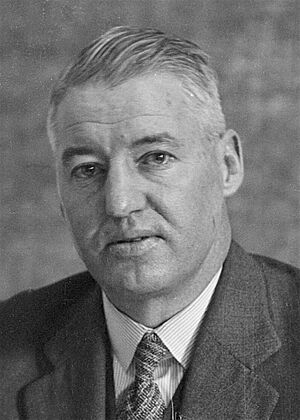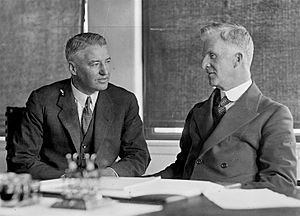Ted Theodore facts for kids
Quick facts for kids
Ted Theodore
|
|||||||||||||||||||||||||||||||||||||||||||||||||||
|---|---|---|---|---|---|---|---|---|---|---|---|---|---|---|---|---|---|---|---|---|---|---|---|---|---|---|---|---|---|---|---|---|---|---|---|---|---|---|---|---|---|---|---|---|---|---|---|---|---|---|---|
 |
|||||||||||||||||||||||||||||||||||||||||||||||||||
| Treasurer of Australia | |||||||||||||||||||||||||||||||||||||||||||||||||||
| In office 29 January 1931 – 6 January 1932 |
|||||||||||||||||||||||||||||||||||||||||||||||||||
| Prime Minister | James Scullin | ||||||||||||||||||||||||||||||||||||||||||||||||||
| Preceded by | James Scullin | ||||||||||||||||||||||||||||||||||||||||||||||||||
| Succeeded by | Joseph Lyons | ||||||||||||||||||||||||||||||||||||||||||||||||||
| In office 22 October 1929 – 9 June 1930 |
|||||||||||||||||||||||||||||||||||||||||||||||||||
| Prime Minister | James Scullin | ||||||||||||||||||||||||||||||||||||||||||||||||||
| Preceded by | Earle Page | ||||||||||||||||||||||||||||||||||||||||||||||||||
| Succeeded by | James Scullin | ||||||||||||||||||||||||||||||||||||||||||||||||||
| Deputy Leader of the Labor Party | |||||||||||||||||||||||||||||||||||||||||||||||||||
| In office 5 February 1929 – 19 December 1931 |
|||||||||||||||||||||||||||||||||||||||||||||||||||
| Leader | James Scullin | ||||||||||||||||||||||||||||||||||||||||||||||||||
| Preceded by | Arthur Blakeley | ||||||||||||||||||||||||||||||||||||||||||||||||||
| Succeeded by | Frank Forde | ||||||||||||||||||||||||||||||||||||||||||||||||||
| Member of Parliament for Dalley |
|||||||||||||||||||||||||||||||||||||||||||||||||||
| In office 26 February 1927 – 19 December 1931 |
|||||||||||||||||||||||||||||||||||||||||||||||||||
| Preceded by | William Mahony | ||||||||||||||||||||||||||||||||||||||||||||||||||
| Succeeded by | Sol Rosevear | ||||||||||||||||||||||||||||||||||||||||||||||||||
| 20th Premier of Queensland Elections: 1920, 1923 |
|||||||||||||||||||||||||||||||||||||||||||||||||||
| In office 22 October 1919 – 26 February 1925 |
|||||||||||||||||||||||||||||||||||||||||||||||||||
| Monarch | George V | ||||||||||||||||||||||||||||||||||||||||||||||||||
| Deputy | John Fihelly William Gillies |
||||||||||||||||||||||||||||||||||||||||||||||||||
| Governor | Hamilton Goold-Adams Matthew Nathan |
||||||||||||||||||||||||||||||||||||||||||||||||||
| Preceded by | T. J. Ryan | ||||||||||||||||||||||||||||||||||||||||||||||||||
| Succeeded by | William Gillies | ||||||||||||||||||||||||||||||||||||||||||||||||||
| 4th Deputy Premier of Queensland | |||||||||||||||||||||||||||||||||||||||||||||||||||
| In office 1 June 1915 – 22 October 1919 |
|||||||||||||||||||||||||||||||||||||||||||||||||||
| Premier | T. J. Ryan | ||||||||||||||||||||||||||||||||||||||||||||||||||
| Preceded by | Thomas O'Sullivan | ||||||||||||||||||||||||||||||||||||||||||||||||||
| Succeeded by | John Fihelly | ||||||||||||||||||||||||||||||||||||||||||||||||||
|
|||||||||||||||||||||||||||||||||||||||||||||||||||
|
|||||||||||||||||||||||||||||||||||||||||||||||||||
|
|||||||||||||||||||||||||||||||||||||||||||||||||||
| Personal details | |||||||||||||||||||||||||||||||||||||||||||||||||||
| Born |
Edward Granville Theodore
29 December 1884 Port Adelaide, Province of South Australia, British Empire |
||||||||||||||||||||||||||||||||||||||||||||||||||
| Died | 9 February 1950 (aged 65) Edgecliff, New South Wales, Australia |
||||||||||||||||||||||||||||||||||||||||||||||||||
| Resting place | South Head Cemetery, Bronte | ||||||||||||||||||||||||||||||||||||||||||||||||||
| Political party | Labor | ||||||||||||||||||||||||||||||||||||||||||||||||||
| Spouse |
Esther Mahoney
(m. 1909) |
||||||||||||||||||||||||||||||||||||||||||||||||||
| Relations | Stephen (brother) | ||||||||||||||||||||||||||||||||||||||||||||||||||
| Children | 4 | ||||||||||||||||||||||||||||||||||||||||||||||||||
Edward Granville Theodore (born December 29, 1884 – died February 9, 1950) was an important Australian politician. He served as the Premier of Queensland from 1919 to 1925. Later, he became the Treasurer of Australia in the federal government led by James Scullin. Theodore was known for his strong ideas about how the government could help people and the economy.
Contents
Early Life and Work
Edward Theodore was born in Port Adelaide, South Australia, in 1884. His father was from Romania and his mother was from England. Edward left school when he was only 12 years old.
He spent the next ten years working in different jobs across Australia. He worked in gold mines in Western Australia and on guano (bird droppings used as fertilizer) mining crews. He also prospected for copper and tin. In 1906, he moved to Queensland.
Starting in Politics
In Queensland, Theodore became very involved in the labour movement. This movement worked to improve conditions for workers. He helped start a union called the Amalgamated Workers' Association. This union grew to become the largest in Australia, the Australian Workers' Union (AWU). Theodore became the Queensland state president of the AWU in 1913.
In 1909, when he was just 24, Theodore was elected to the Queensland Legislative Assembly. This was Queensland's state parliament. When the Labor Party won the state election in 1915, Theodore became the Treasurer of Queensland. He was also in charge of Public Works.
Premier of Queensland
In 1919, Theodore became the Premier of Queensland. At this time, Queensland was the only Australian state with a Labor government. He was a popular leader. People even started talking about him becoming a federal leader.
His government introduced many new ideas to help the economy and workers. They set up several state-owned businesses. They also brought in new rules to make sure businesses were fair and to improve working conditions. Because of these ideas, some people called him "Red Ted."
One big change Theodore made was getting rid of the Queensland Legislative Council in 1922. This was the upper house of Queensland's parliament. Queensland is still the only Australian state that does not have an upper house.
Theodore's government also helped with education, especially for people with disabilities and those in isolated areas. They made it easier for adults to vote in local elections. Workers got benefits like unemployment schemes and better safety rules. There were also improvements in housing and support for farmers. Theodore won two state elections before he decided to leave state politics in 1925 to try for a seat in the federal parliament.
Federal Politics and the Great Depression
Theodore tried to enter federal politics in 1925 but lost his first election. However, two years later, he won a special election in Sydney for the seat of Dalley.
In 1929, he became the Deputy Leader of the Labor Party under James Scullin. When Scullin became Prime Minister in October 1929, Theodore became the Treasurer and was effectively the Deputy Prime Minister.
Dealing with the Great Depression
Just two days after Theodore became Treasurer, the US stock market crashed. This led to the Great Depression, a time of huge economic hardship around the world. Australia's economy, which relied on exports, was hit very hard. Many people lost their jobs.
Theodore believed the government should spend more money to help the economy recover. This was a new idea at the time. However, some other politicians wanted a more traditional approach, which meant cutting government spending.
In July 1930, Theodore had to resign as Treasurer. There were questions about his business dealings when he was Premier of Queensland. This event was known as the "Mungana affair".
Without Theodore, the government struggled even more. When it became clear that he would not be charged with any crime, Prime Minister Scullin asked Theodore to return as Treasurer in January 1931. This caused some other ministers to resign in protest.

In 1931, Theodore faced the biggest economic crisis in Australia's history. He suggested a plan to print more money to help farmers and small businesses. This idea was called "fiduciary notes." However, banks and many economists thought this was a bad idea. The plan was eventually rejected by the Australian Senate.
In late 1931, the Labor Party split over these economic disagreements. This led to an election in December. Theodore lost his own seat in this election. He was only 47 when he left politics. He was the only sitting Treasurer to lose his seat until 2022.
Life After Politics
After leaving politics, Theodore started a very successful business career.
Newspaper Business
In 1932, Theodore teamed up with a young man named Frank Packer. They bought a struggling newspaper and planned to rename it The Star. However, a rival newspaper company paid them a large sum of money not to publish a daily newspaper for three years.
Theodore used this money to invest in other newspaper businesses. He and Frank Packer then decided to create a new weekly magazine for women. This magazine was called The Australian Women's Weekly. It became incredibly popular. In 1936, Theodore and Packer joined with another company to form Australian Consolidated Press (ACP). Theodore became the chairman of this new company.
Gold Mining in Fiji
In 1933, Theodore learned that gold had been found in Fiji. He decided to invest in this discovery. He formed a group with Frank Packer and others to explore the area. They eventually set up three successful gold mines: Emperor, Loloma, and Dolphin. Theodore became the managing director of all three.
He cared about the miners' well-being. He advised the government on health benefits and workers' compensation. The mining town had schools, sports facilities, and a hospital. Theodore's success in Fiji led to him being asked to look for gold in other places like Borneo and the Solomon Islands. He even lived in Fiji for a time.
Helping During World War II
In 1942, during World War II, Prime Minister John Curtin asked Theodore to help organize Australia's resources for the war effort. Theodore agreed to lead the Allied Works Council. He also created the Civil Constructional Corps (CCC). This group was responsible for building things the military needed.
Theodore faced some challenges in this role, but he worked hard to get the job done. He eventually left the position in October 1944.
Later Years and Legacy
After the war, Theodore continued his business work in Fiji. However, in 1947, he was diagnosed with a serious heart condition. His health got worse, and he started to hand over his business responsibilities to his children. He resigned from ACP in 1949.
Edward Theodore died on February 9, 1950, at the age of 65. He was buried in South Head Cemetery in Sydney.
Historians believe that the questions about his business dealings likely stopped Theodore from becoming Prime Minister. However, he is still seen as one of the most talented Labor politicians who never held that top job.
Named in his honour
Several places and things have been named after Edward Theodore:
- Theodore, a town in Queensland.
- Electoral district of Theodore, an election area in Queensland.
- Theodore, a suburb in Canberra.


